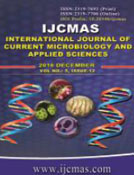


 National Academy of Agricultural Sciences (NAAS)
National Academy of Agricultural Sciences (NAAS)

|
PRINT ISSN : 2319-7692
Online ISSN : 2319-7706 Issues : 12 per year Publisher : Excellent Publishers Email : editorijcmas@gmail.com / submit@ijcmas.com Editor-in-chief: Dr.M.Prakash Index Copernicus ICV 2018: 95.39 NAAS RATING 2020: 5.38 |
Health care workers (HCW) are at risk of an occupational exposure to blood borne most commonly by percutaneous injuries with sharp objects. This study was conducted to find out the occurrence of NSI’s among HCW in a tertiary care hospital. A retrospective study was conducted in Department of microbiology at a tertiary care hospital in which data of all self-reported documents related to NSI for the period from 2013-2015 was collected and analyzed to determine the group of the HCW suffering the injury with details of the incident including mode of injury, different majors followed after injury and the status of post-exposure prophylaxis. Out of total 1295 HCW, 15 (1.16%) have reported the incidence of NSI’s in 2013, 14 (1.08%) in 2014 & 17 (1.31%) in 2015. Among these total 46 HCW, interns were the most commonly injured group followed by doctors (7.08%), laboratory technicians (3.51%), nurses (0.9%) & servants (0.3%). Recapping of used needle was most common mode of injury 19 (41.31%) followed by suturing, splashing over open wound or mucous membrane or eyes, while IV catheterization or drawing out of blood, during drug administration & handling of biomedical waste. Most of HCW’s had washed the site with spirit or betadine. Among 46 HCW’s 27 (58.70%) had completed the PEP. Understanding the epidemiology of NSI’s is very important to implement control measures. Compulsory clinical training of medical students in their academic is a must to prevent NSI’s.
 |
 |
 |
 |
 |